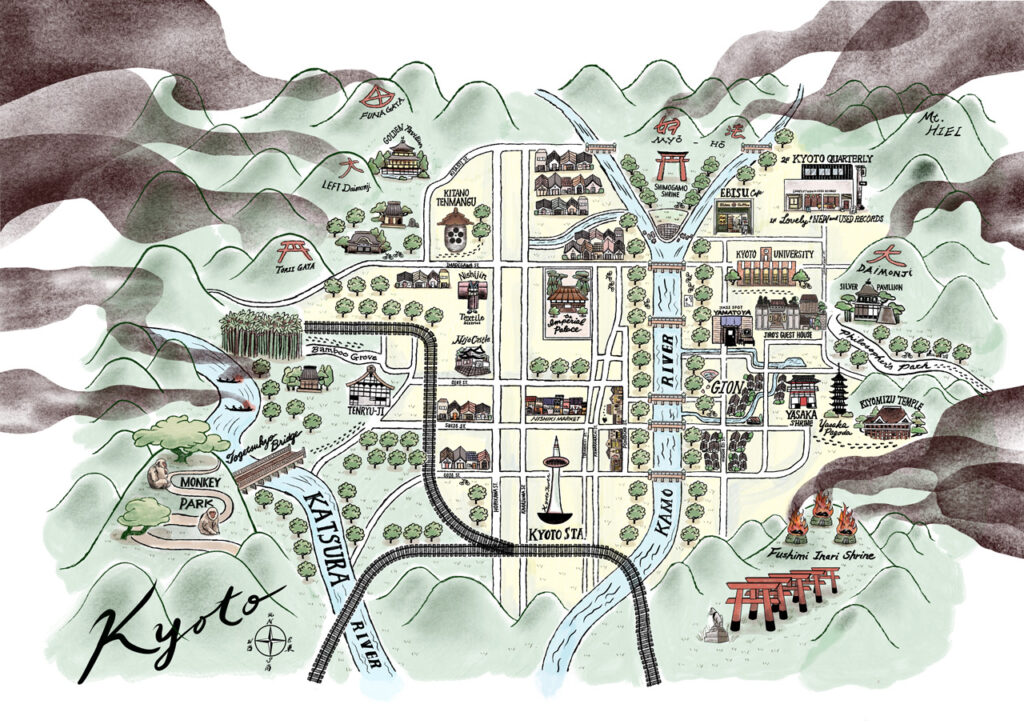A Book of Love
I attended the launch in Kyoto of this book on November 22 last year, wrote it up (you can find the writeup in the newly refurbished website), and I agreed to write a review of the book as well. However, due to various matters especially the rituals of New Year, I was unable to write it until now. Apologies to Tina and others who were waiting.
This is a book of love, and it is also a murder mystery — I think in that order. The love comes from the love of a mother for her son who has chosen to live far away, and of that same mother for that place where her son lives. Tina mentioned at the launch interview that she chose the word “embers” because of the various fire festivals in Kyoto which the main character visited, which are depicted on a lovely map drawn by Elisa Tanaka (who also created the beautiful book cover), and also because the word “embers” gives a cozy feeling.
Bianca is the protagonist and detective, who moved to the small town of Batavia-on-Hudson, New York, and has forged her place there through two earlier novels, Winter Witness and Dead Man’s Leap (which were both nominated for the prestigious Agatha Award). She has a deep connection to the city of Kyoto, and her son has made his home there. This, the third book in the series, is set largely in Kyoto — the subtitle is “a Batavia-in-Hudson Mystery in Kyoto” — and many small details reveal Bianca’s, and the author’s, love for the city and familiarity with it.

This is a bold move — to juggle two scenarios at once, Kyoto (where the protagonist is visiting) and Batavia-on-Hudson (which she calls home, and where she has a budding romantic interest: the local sheriff, who happens to be up for reelection). There are many attendant problems to do with timing — for example, the time difference must be accounted for when planning telephone calls, etc. But in part thanks to the small size of chapters, the author manages this admirably. Each chapter helpfully notes the location at the top, so we can keep track of where we are as we read.
As a matter of fact, this book is helpful to the reader in many ways, which is one rather under-mentioned way to judge a book. Location tags, maps, illustrations, and lists (such as a list of characters, which Tina also helpfully provides at the front) are ways that authors can make it easier for their readers to enter and navigate the world of the book. Tina uses these in a masterful way. Kudos for that.
I noticed the love of family and the love of place, and felt that the actual mystery, the murder of a ne’er-do-well foreigner, was somewhat of an adjunct to the actual story, which deals with the protagonist’s identity search, and also the process of watching her son as he forges his own identity in Kyoto. The author says at one point, after connecting with the myth of the fox, who is a trickster and shapeshifter in Japanese stories, “… Bianca thought about how well mythology can capture the paradoxes of our personalities. How we were two people at once — maybe even several people. How sometimes we weren’t even sure which one was our real self — and how we tried these identities on for size over the years before we had a good sense of who we really were.”
This is true of everyone from outside who makes Japan their home, and is probably true of every person, especially those who find themselves thinking of somewhere other than their birthplace as home; identity search is part of every human being’s life journey.
There are dream sequences and live action, family and city and small-town relationships skilfully woven; there is something for everyone, but for me this will always be a book of love. Reading it, people who love Kyoto will find a wealth of detail about their favorite city, and they may also be tempted to sample the previous books in the series, as well as anticipating what will happen in the next one.

